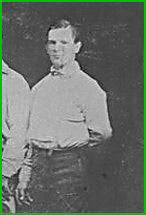

George H. Flanley was born in Brooklyn, NY on 7th June 1840, the son of William and Margaret (née Byrne) Flanley. His father William was born in NY and died there in 1855. His mother Margaret is believed to have been born in Ireland in 1817. She is found in the records as a widow living with her daughter Kate Flanley Bixby in Brooklyn at the time of the 1880 US census. George had at least one other sibling, a sister Mary, born on 16th June 1845.
George was a close friend and sidekick of one of the most famous early American baseball legends: Jim Creighton, but George is remembered as well for his own prowess in the early years of America’s national pastime. Creighton, born in Manhattan on 15th April 1841, was the son of Irish immigrants and, like his friend George Flanley, grew up in Brooklyn. At the age of 16, the neighborhood boys started a junior baseball club they called Young America. A few games were played in 1857 and then the group disbanded. Soon, however, George and Jim started the Niagaras of Brooklyn, George playing shortstop and Jim at second base.
In 1859, George and Jim joined the Star Club, a top-flight junior team of that time. By 1860, George and Jim joined the Excelsior Club. As the story has been told, they were courted by the Excelsiors who wanted desperately to overtake their Brooklyn rival, the Atlantics. George and Jim have been called baseball’s first “professional players” as they received incentives from the Excelsiors. One of the highlights of their time with the Excelsiors was the greatest event of the 1861 season, the Great Silver Ball Match, played on the Mutuals’ Grounds in Hoboken, NJ. This was an all-star contest between teams from New York and Brooklyn. Fifteen thousand spectators turned out for the game in which George played center field and Jim was the star pitcher. Their Brooklyn team routed their New York opponents by a score of 18 to 6.
In October 1862, the Excelsiors played a very tough match against the Unions of Morrisania. Game attendees who later recounted what they saw said that Jim crossed home plate after hitting a home run and turned to George saying “I must have snapped my belt.” George reportedly replied, “I guess not.” Tragically, Jim would die four days later, most likely from a rupture of some kind.
So, what became of George after the death of his close friend? He did continue to play baseball and can be found on the 1869 New York Mutuals roster as second baseman. US census records show that George married his wife Julia in about 1865 in New York. In 1870, the couple (then childless) are boarders in Brooklyn’s 4th Ward. George and Julia Flanley had five children between 1871 and 1887: Frederick William, Cora, Madeline (aka Amanda), Chester and Emily. In 1880, George was a telegraph supervisor in New York. By 1885 and until the late 1890s, the family was living in Kansas where George worked as an electrician. By 1900, the family relocated to Chicago and George was still working as an electrician, his stated age 59. In 1910, the family still resided in Chicago and George, then 69, was retired and living on his “own income”. By 1920, Julia is widowed after a half century’s life alongside a pioneer in American organised baseball.
[his portrait is illustrated above; courtesy of 19th Century Baseball]